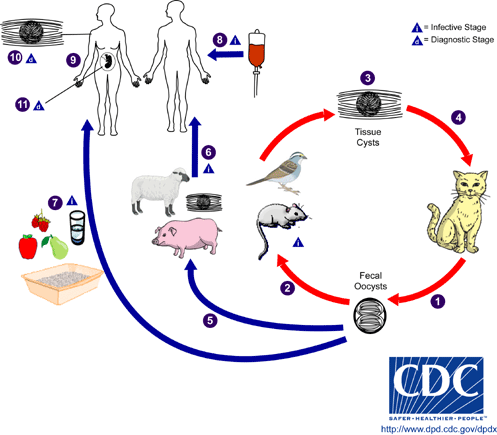Despite numerous technological advances, fleas
continue to represent a potentially lethal plague upon our pets. Current
products are effective so there is little reason for this; the problem seems to
be one of understanding.
.jpg)
There are over 1900 flea species in the world. Pet owners are concerned with
only one:the cat flea. This is the flea that we find on
our pets (cats, dogs, rabbits, and other species) in 99.9% of cases and in
order to understand how to control the damage caused by this tiny little
animal, you should learn all you can about it.

What Kind of Damage
Can Fleas Cause?
It would be a grave mistake to think of the
flea as simply a nuisance. A heavy flea burden is lethal, especially to smaller or younger animals. Conditions
brought about via flea infestation include:
• Flea Allergic Dermatitis (fleas do not
make animals itchy unless they have a flea bite allergy)
• Flea Anemia (your pet is loosing blood every time a flea feeds)
• Feline Infectious Anemia (a life-threatening blood parasite carried by
fleas)
• Cat Scratch Fever/Bartonellosis (does not make the cat sick but the
infected cat can make a person sick)
• Common Tapeworm infection
Fleas can kill pets.
Myths Veterinarians
Hear Nearly Every Day:
• My pet cannot have fleas because he lives entirely indoors. Actually,
the fleas really like living inside your home, and it is not at all hard for
them to get there.
• My pet cannot have fleas because if there were any fleas they would be
biting me. However, fleas do not prefer
human blood, and won’t start biting you and your family unless they have to.
 |
| This dog has flea allergy dermatitis: or an allergy to flea bites |
• We do not have fleas because we have only hard wood floors. But
really, Fleas love to develop in the cracks between the boards of hard wood
floors.
• My pet cannot have fleas because I would see them. This is
the hardest truth!! Your pet grooms the fleas off by biting and chewing and
consuming them. You will only see
evidence there were fleas by the skin infection in a majority of cases. If you are seeing the fleas on your pet, he
has way more than he can groom off!!
 |
| Cats also get flea allergy dermatitis |
Fleas are adaptive and
their life cycle is always active: eggs are laid, larvae are developing, pupae
are growing, etc. The environmental temperature controls how fast this occurs.
If you want to eradicate the flea population in a specific home, it is best to
attack when numbers are low in the winter. It is a mistake to stop flea control
products in the winter as it will be much harder to gain the upper hand in the
spring and summer when the populations are rising.
The MORAL OF THE STORY IS THAT FLEAS SHOULD
NOT BE UNDERESTIMATED AND IT IS IMPORTANT TO HIT THE FLEA POPULATION WHEN IT IS
WEAKEST. HIT THEM HARD!!
.jpg) The Flea Life Cycle
The Flea Life Cycle
There are four
life stages of the flea and it is important to know how to break this life
cycle in more than one place. This two-step approach provides the most rapid
control and the least resistance to flea control agents in future flea
generations.
The Egg
At any given time about one third of the flea
population in someone’s home is in the egg stage. The adult female flea lays up
to 40 eggs daily. The eggs are laid on the host where they fall off to hatch in
the environment.
The Larvae
At any given time about 57% of the fleas in
someone’s home are in the larval stage. Larvae are like little caterpillars
crawling around grazing on the flea dirt that is generally in their vicinity.
Flea eggs and flea dirt both fall off the host. When the eggs hatch, there is a
bounty of food prepared lovingly by all the host’s fleas waiting for the
hatchlings. This is the stage that picks up tapeworm eggs, which are likely to
be in the vicinity, as they graze.
The larval stage is capable of cocoon formation and hang around as pupa indefinitely until conditions are right.
The Pupae
By this life stage most young fleas have been
killed off by an assortment of environmental factors. Only 8% make it to the
pupal stage but once they have spun cocoons they are nearly invincible. The
cocoon is sticky and readily picks up dust and dirt. Inside the developing
cocoon, the pupa is turning into the flea that we are familiar with. They are
especially protected under carpet, which is why carpet has developed such a
reputation as a shelter for fleas.
The pupa can remain dormant in its cocoon for
many months, maybe even up to a year as it waits for the right time to emerge.
The Unfed Adult Flea
After the pupa develops, it does not
automatically emerge from its cocoon. Instead, it is able to remain in the
cocoon until it detects a nearby host. The mature pupa is able to detect the
vibrations of an approaching host, carbon dioxide gradients, and sound and
light patterns. When the mature pupa feels the time is right, he emerges from
the cocoon, hungry and eager to find a host.
A common scenario occurs when a dog is boarded
during the owner’s vacation. The owner picks up the dog from the boarding
kennel and returns home. The mature pupae have been waiting for a host and when
the dog enters the home, a huge number of adult fleas emerge at once and attack
the dog creating a sudden, heavy infestation. Often the boarding kennel is
blamed for giving the dog fleas. What really happened was that the pupae waited
to emerge while there was no host present and then they all emerged suddenly
when the host arrived.
An unfed flea is able to live for months
without a blood meal but during that time it is aggressively using all its
powers to locate a host. Once it finds a host, it will never purposely leave
the host.
The Fed Flea
After the adult flea finds a host and takes
its first blood meal, metabolic changes occur that alter the flea forever. The
flea is now called a fed flea and, if separated from its host, will die in only
a few weeks without a blood meal. The
female flea begins to produce eggs within 24 to 48 hours of her first blood
meal and will lay eggs continually until she dies.
The
average life span of the adult flea is 4 to 6 weeks, depending on the grooming
abilities of the host.
ON AVERAGE, THE TIME PERIOD FROM EGG TO ADULT
FLEA IS ABOUT 3 WEEKS.









.jpg)




.jpg)


































